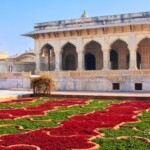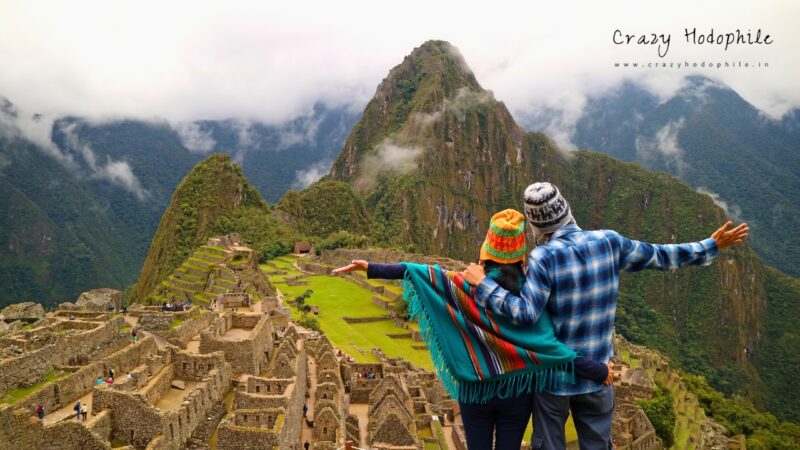Planning a Taj Mahal Trip in 2024? This Guide is Essential | Crazy Hodophile
The Taj Mahal, a breathtaking monument of white marble, stands as a testament to the Mughal emperor Shah Jahan’s deep affection for his wife, Mumtaz Mahal. Built-in Agra between 1631 and 1648, it is a jewel of Muslim art in India and a universally admired masterpiece of the world’s cultural heritage.
Table of Contents
A History Etched in Marble
Shah Jahan commissioned the Taj Mahal in memory of Mumtaz Mahal, who died in 1631 after giving birth to their 14th child. The emperor poured his grief and love into the creation of this exquisite mausoleum, employing thousands of artisans and craftsmen over two decades.
Architectural Splendor
The Taj Mahal’s architecture is a harmonious blend of Persian, Islamic, and Indian styles. The main structure is a perfectly symmetrical square with chamfered corners, each side measuring approximately 55 meters. Each facade is adorned with a grand pishtaq (a vaulted archway) flanked by two arched balconies, creating a sense of balanced elegance.
Four towering minarets, over 40 meters tall, stand at each corner of the platform. These minarets, divided by two balconies and crowned with pavilions, mirror the graceful curves of the main dome.
The most striking feature is the magnificent marble dome that crowns the tomb. Reaching a height of 35 meters, including the cylindrical drum beneath it, the dome is often described as an onion dome due to its distinctive shape. A lotus design adorns the top, further accentuating its height. Four smaller domes encircle the main dome, creating a sense of visual harmony.
Light and Symmetry
Inside, an octagonal chamber houses the cenotaphs of Shah Jahan and Mumtaz Mahal, illuminated by soft, diffused light. Intricate marble screens, pietra dura inlay work, and verses from the Quran in elegant Thuluth script adorn the walls, adding to the ethereal beauty of the space.
Interesting Facts about the Taj Mahal
- Changing Colors: The Taj Mahal appears to shift colors throughout the day as sunlight reflects off its pristine white marble, giving it a dynamic and ever-changing appearance.
- Construction Timeline: Construction of the Taj Mahal spanned 22 years. The main mausoleum was completed in 1648, with the entire complex, including the surrounding buildings and gardens, finished in 1653.
- Optical Illusion: The Taj Mahal gives the illusion of being smaller when viewed from afar and appears larger as you approach, due to an optical illusion created by the surrounding structures.
- The Minarets: The four minarets surrounding the Taj Mahal are intentionally tilted outward. This design feature was meant to prevent them from falling onto the main structure in the event of an earthquake.
- Graves of Shah Jahan and Mumtaz: The graves of Shah Jahan and Mumtaz, which are visible in the central hall of the mausoleum, are not actually in that location. They are located in a chamber beneath the main hall of the Taj Mahal.
- Black Taj Mahal: Legend has it that Shah Jahan intended to build a black Taj Mahal across the river as his mausoleum, but his son Aurangzeb halted the project.
Gallery
Visiting the Taj Mahal
Opening Hours
The Taj Mahal is open from sunrise to sunset, except on Fridays.
Entrance Fee
- No entry fee for children below 15 years.
- Indian citizens: ₹50
- Citizens of BIMSTEC and SAARC countries: ₹540
- International visitors: ₹1100
- An additional ₹200 is charged to enter the main mausoleum.
Best Time to Visit
Sunrise: Arrive early to witness the Taj Mahal bathed in the soft golden light of dawn. This is a magical time as the white marble gradually changes color with the rising sun. It’s also a good time to avoid the crowds.
Sunset: Experience the beauty of the Taj Mahal as the sun sets, casting long shadows and creating a romantic atmosphere. The monument takes on a warm glow as the day comes to a close.
Full Moon Nights: For a truly unforgettable experience, consider visiting the Taj Mahal on a full moon night. The monument is open for night viewing on five nights each month: the full moon night and the two nights before and after.
- Night Viewing Timing: 20:00 hrs. to 23:59 hrs. in 8 batches of max. 50 people each.
- Ticket prices are ₹510 for Indian adults, ₹750 for foreign adults, and ₹500 for children aged 3 to 15 years, regardless of nationality.
- Website for booking: https://asi.paygov.org.in/asi-webapp/#/ticketbooking
Tips for Visiting
- Hiring a Guide: To avoid being overcharged, solo travelers who hire guides should always bargain beforehand.
- Agra’s Famous Sweet: Agra’s Petha is renowned, with “Panchhi Petha” being the most famous. However, many shops falsely claim to sell it under this brand. This is a common tactic to deceive tourists and charge inflated prices. To avoid being misled, purchase only from the original outlet.
- Morning Visits in Summer: Arrive early in the morning during summer to avoid the heat, as the marble gets very hot under the sun.
- Shoe Covers: Buy shoe or slipper covers for ₹5-₹10 at the entrance since footwear without covers is not allowed inside the mausoleum. This helps maintain cleanliness.
- Keep Your Ticket Ready: Carry an e-copy or printout of your ticket for smooth entry during security checks.
- Night Viewing: Experience the Taj Mahal’s enchanting beauty under the moonlight on full moon nights. Limited tickets must be booked in advance.
- Photography Rules: Photography is allowed in most areas but may be restricted inside the main mausoleum. Always confirm with the authorities before taking pictures.
How to Visit
- By Air: The nearest airport is Agra Airport (AGR), also known as Kheria Airport, located approximately 12 kilometers from the Taj Mahal. From the airport, you can hire a taxi or take a pre-paid taxi service to reach the monument.
- By Train: Agra is well-connected by rail to major cities in India. The Taj Express and Shatabdi Express offer convenient connections to Agra Cantt Railway Station. From the railway station, you can hire a taxi, or auto-rickshaw, or take a cycle rickshaw to the Taj Mahal.
- By Road: Agra is well-connected to major cities like Delhi via the Taj Express Highway (Yamuna Expressway), approximately 233 km, offering a drive of about 3 hours and 45 minutes.
- By Bus: The Idgah Bus Stand, the main bus terminal, is located 8 km from the Taj Mahal and connects to local buses, auto-rickshaws, and taxis.
Note: The parking area is near the Western Gate, from where you can find different modes of transport including tongas, camels, and e-rickshaws at nominal rates to ferry you to and from the complex.
Location Map for Taj Mahal
Nearby Attractions
Enhance your visit by exploring these nearby attractions:
- Taj Museum (Located within the complex): Discover artifacts and learn more about the history of the Taj Mahal.
- Taj Mahal Garden (Adjacent to the Taj Mahal): Stroll through the serene Char Bagh gardens, designed in the classic Mughal style with reflecting pools and fountains that symbolize paradise.
- Mehtab Bagh (8 km by road, 300 meters by boat from the Taj Mahal): Witness mesmerizing views of the Taj Mahal from this tranquil garden, especially enchanting during sunset.
- Agra Fort (3 km from the Taj Mahal): Explore the majestic red sandstone fort, another UNESCO World Heritage Site.
- Anguri Bagh: Explore this charming garden within the Agra Fort, known for its beautiful layout and historical significance.
- Itmad-ud-Daulah’s Tomb (7 km from the Taj Mahal): Known as the “Baby Taj,” this tomb served as an inspiration for the Taj Mahal.
Related External References:
- Taj Mahal Interesting Facts On Shahjahan Cut Hands Of Workers What Is The Truth Behind?
- A much-maligned Mughal
- Taj Mahal to undergo major renovations for survival
Last Updated on 29 November, 2024














i like your blog soo much
Thanks for your compliment.
Loved the picture and the content here!
Thanks for your compliment.
What a information. 👍👍👍👍
I appreciate your feedback!